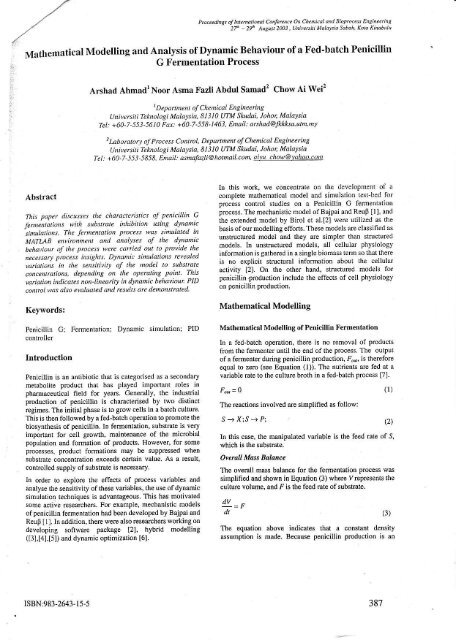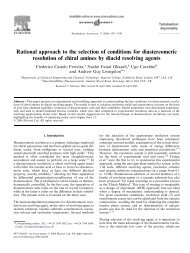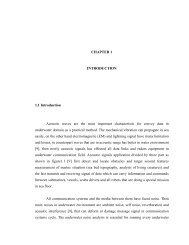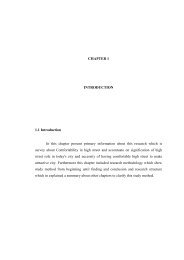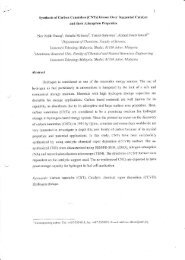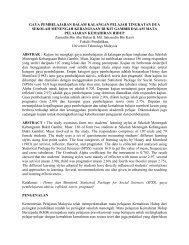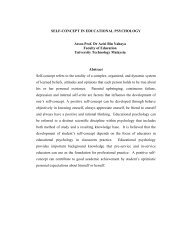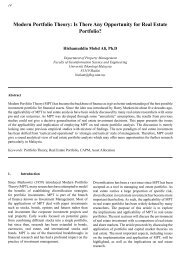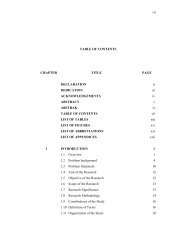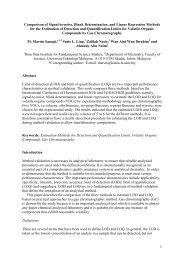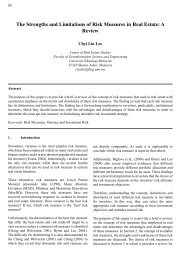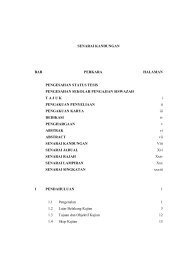Mathematical Modelling and Anatysis of Dynamic Behaviour of a Fed
Mathematical Modelling and Anatysis of Dynamic Behaviour of a Fed
Mathematical Modelling and Anatysis of Dynamic Behaviour of a Fed
Create successful ePaper yourself
Turn your PDF publications into a flip-book with our unique Google optimized e-Paper software.
Praceadings <strong>of</strong> I'{enotiahol ConfeEn e on chehtical an l Biopn.es E\iaceting<br />
27' 2q A4u!2003, Uniwrsiti Malqria Sabah Kotu Kintua l<br />
<strong>Mathematical</strong> <strong>Modelling</strong><strong>and</strong><br />
<strong>Anatysis</strong> <strong>of</strong> <strong>Dynamic</strong> <strong>Behaviour</strong> <strong>of</strong> a <strong>Fed</strong>'batch Penicillin<br />
G Fermentation Process<br />
Abstract<br />
Arshad Ahmadl Noor Asma Fazli Abdul Samad2 Chow Ai Wei:<br />
'Depdrtment aJ chenical Engi@enng<br />
Unireniti Teknalosi Malarsia, 8 1 3 1 0 UTM Skudai, Jahoa Mata)sia<br />
TeL +6A-7 553-5610 Far: +60'7'558'1463, Enait: a\hdd@fl
aerobic fermenirtion process. the lbrmentat'on cuLure rs<br />
continuously sparged with air. The air leaves tho fementer<br />
through the exhdust gas line lf the a;r enlering the ferment€r<br />
is dry. water is conlinually stfipped from lhe mednnn <strong>and</strong><br />
Ieaves the system as vapour. Evaporative water losr can be<br />
significant over a period oldays [8]. Typically, l0-2oc' <strong>of</strong><br />
he roral ororh car oe o\. due In e\aPoralion dunng one<br />
week <strong>of</strong> femenration. the actual amount depending on the<br />
lempemrure <strong>of</strong>the iementalion [2]. Hence, evaPorative loss.<br />
FL* shoLrld be taken into accoun! in modelling <strong>of</strong>atermenter.<br />
ln addilion. the eftbcl <strong>of</strong> ac;d,4rase addition on the loral<br />
volume change <strong>of</strong> the cuhure b.olh. Fdb should also be<br />
included in Equrlion (3). By including all these erms' the<br />
olenll nrass balancc fo.a ftfmenlercan be expressed as:<br />
The suggested evapo.ative loss can be represented by the<br />
follo$ing rela!ionships [2]:<br />
Ft,., = V )G51o<br />
rdt^ '') \<br />
(4)<br />
(5)<br />
Here, f. <strong>and</strong> I, are the frcezing <strong>and</strong> boiling enPerature <strong>of</strong><br />
the culture medium lbat were asslmed io have rhe same<br />
properties as water, respeclively, <strong>and</strong> ,l is a sugg€sEd<br />
evapomtion rale <strong>of</strong>2.5 x 10" l/h al the operation tempemlure<br />
<strong>of</strong> 25 'C I2l. Here, the mte <strong>of</strong> evapomdon apProaches<br />
infinity at the boiling point, <strong>and</strong> for engineering purposes the<br />
exponent 5 h large enougb to represent this [2]<br />
Mass Aalance ot Biomass<br />
The equadon for mass balanceon biomass is simplified as:<br />
dt v dt (6)<br />
where X is ihe biomass concent.ation <strong>and</strong> I is lhe specific<br />
growth rale <strong>of</strong>the biomass. The specific growth mtd can be<br />
described by Monod model (Equation (7)). where fte<br />
microorganisms' growth .ale depetds on the concentmtlo.<br />
<strong>of</strong>limiting nur.ient ([8]it9l;ll0l: [l ll)<br />
s<br />
' rK.+s)<br />
H€re, tx represents the maximum specific growth rate, <strong>and</strong><br />
Kl is the substfate satumtion constant. However the Monod<br />
model is inaccurate to describe the growtb under certa'n<br />
condilion' Ll2l. Ite modeti' only valid lor balanced SrowIh<br />
<strong>and</strong> should not be applied when grolvlh conditions are<br />
changing rapidty t8l. Numerous modifications we€ made to<br />
Monod model to improve accuracy <strong>of</strong> the kinetic model. one<br />
example is the Conlois kinetics thal is used to rcpresent the<br />
diffusioral limitations thai occur at high biomass<br />
concentrations (tlOlitlzl). The Conrois kinetics nodel is<br />
given by equation (8) below.<br />
s<br />
' ''(K,X+Sl<br />
388<br />
0)<br />
(8)<br />
Pneedin{ oJ lntenrrli.rol ConJercnce On ChMi t tnd Biorraees Engnrcariry<br />
2/r 2qn AuN2AD3 Unie^iti Makttlia:;ahah, Kata Kil.bolu<br />
For the Bajpai <strong>and</strong> Reup model til. distolved oxlgen<br />
concentration C. <strong>and</strong> oxygen limitalion constant (ox are<br />
included in Equation (8) to sivel<br />
,=,,@i;o,.#.c, (e)<br />
According 10 Birol e, al. t2l, effects <strong>of</strong> environmental<br />
vadables such as pH <strong>and</strong> lemperature should also be taken<br />
into account in the specific Srowth expression- These<br />
variables play imp<strong>of</strong>tnnt roles on lhe qualily <strong>and</strong> quantily <strong>of</strong><br />
the final product. Considering these vadables, lhe specific<br />
growth rate is now given byl<br />
C.<br />
- Lr+l(4H l'LH ,K ll{^.x+"),/(.Y+r '<br />
. ^ .rl<br />
lli<br />
",J -11 - i *J :.llf<br />
' ' R/ ll 8r'l<br />
Ellec. oJ pH<br />
,.,<br />
,<br />
Another term to consider in the specific growth rate<br />
expression is the hyd.ogen ion concenttation [H'] l2l The<br />
pH <strong>of</strong> the culture medium becomes acidic. as lhe<br />
concentration <strong>of</strong> biomass increases. lhe amounl <strong>of</strong> NH4OH<br />
added into the cullure medium aho incfeases in order to keep<br />
rh€ pH constant duliDg the pe.icillin fermentrtion. Based on<br />
lhis observation, the hyd.ogen ion concentfation is related to<br />
biomass formation as [2]:<br />
dtH't , .. rx, I a*JIa ,qJoL,,,,1r<br />
--'AN-<br />
-<br />
'l-<br />
In j;<br />
,.// \ ",1<br />
a is given as:<br />
^ [ro* rla't- ta'tiv - c,,"1F + F")^t<br />
"=-- n+lF;TE,<br />
(l l)<br />
Here, 4 <strong>and</strong> 16 rcpresent acid <strong>and</strong> base flow rates in Uh'<br />
fespecdvely, where the conc€ntration in both soLurions, C$<br />
are assumed €qual to be 3 M. Besides that, Birol et al. [2]<br />
aho suggesled rhal undet pH conlrol. (he hydrcSen ion<br />
concenlration can be calculated by taking the disassociaion<br />
<strong>of</strong> water <strong>and</strong> acid.4)ase into account as well as the hydrogen<br />
production. The propo.tionality constant, 7 is estjmated as<br />
l0' mol [r]/s biomass.<br />
Efect o! TenPqatwe<br />
(t2)<br />
According to Doran [8], temperature hd a significant kinetic<br />
effect on reactions. The effe.t <strong>of</strong> temperature on the specific<br />
growih rate can be represen!€d by an Anhenius type <strong>of</strong><br />
' "'{l-' ".'( *l'l l-".'('#)li(13)<br />
ISBN:983-2643-15-5
He€, & <strong>and</strong> A! are lhe constant <strong>and</strong> dctivation energy f<strong>of</strong><br />
grc*lh. $hile td ,nd td arc the conslant rnd activation<br />
e.er8y ior dealh. respectively.<br />
Tenpercture Contrcl<br />
The tempefatu.e <strong>of</strong>the culture medium was keptconstanl ar<br />
25 "C. It was conlrolled by a sptit-mnge PID controller lhat<br />
.llors lhe hcating or cooling water flow mte to be<br />
rnanipula|ed. The velociry form <strong>of</strong>the digital PID algorithm<br />
(as shown ;n Equation (14)) was used.<br />
AMy. =A,(8, E" +:::8. -!<br />
|, N<br />
x(cvN<br />
-zcvN )+cvN )DMVN<br />
( t4)<br />
Here. Kc is the proporrional gain, ./ is the inte8ral consran t, .i<br />
is rhe derivarive constanr <strong>and</strong> Cyr,<br />
-tP, <strong>and</strong> My! represent<br />
fie cuflent values <strong>of</strong> rhe conrolled variable, set poinl <strong>and</strong><br />
conlroller ou tput al lhe cunent saorple N, respectivety, with<br />
the curenr lalueoleftor. ttr (=SPr- Cy,).<br />
Mats Aabnee on Peticillitl<br />
For a fed batch fermeniatjon prccess wilh peniciltin<br />
concentradon. P <strong>and</strong> culrure volume, y. specific penicillin<br />
production ra!e, tpp, <strong>and</strong> penicillin hydrolysis constanr, &<br />
tbe mass balance equation on penicillin is reduced rc:<br />
dP .. ..- P dv<br />
dt V d,<br />
,lst<br />
The specific penicillin p.oduclion mre, tpp is defined as<br />
Equarion<br />
( I6) t ll.<br />
s c,"<br />
t'"' = t'"p
Il<br />
"'- ' (r. -t) . -lrt<br />
tu<br />
'.<br />
vp .l<br />
- ?+ ., - --\<br />
t | \ar l zP |.. IJ \2tl<br />
Here, ?l is lhe feed remperature <strong>of</strong> lbe subsraie. f is lhe ieed<br />
now raie <strong>of</strong> the substlale, F. is the flow rate oi the cooling<br />
liquid, p is the density <strong>of</strong> lhe cullure medium pc rs the<br />
d;nsny <strong>of</strong> lhe cooling liquid, c,, <strong>and</strong> .F reprcsent the heat<br />
capacity <strong>of</strong> the culture nledium 3nd the cooling liquad<br />
rcspectively. 0.,, is the heat <strong>of</strong> reaction, a <strong>and</strong> b areconstants'<br />
Forft;s panicular equation, fte u.il <strong>of</strong> Fis g/(l-hr)<br />
Reacdons i. bioprocesses occur as a result <strong>of</strong> enzvme<br />
aclivitv <strong>and</strong> cell metabolism For heat generalion caused bv<br />
nicrobial reactions/metabolism, Birol er dl. t2l has<br />
suggesed the following eqtratron:<br />
!9-=, 4Lv<br />
*,, xv<br />
Time, t (h)<br />
Heat transfer coefficienl <strong>of</strong><br />
heatins/cooling liquid (caUtr."C)<br />
122)<br />
Ptu.zeak|t o.f ht.nrati.nol ConJercnce An Ch.,tical a Bialta.z$ bt?LLeitlg<br />
21 2Er Awrn2003. Unit^iti i\|aldrsid Sabah, Kota Kinabalu<br />
(./0.,,"/d0 is the volumetric heal ptuduction rate. rqr is<br />
assumed rc be coneant <strong>and</strong> might be rfeated as a yield<br />
coeffrcienr, <strong>and</strong> rq, is a constart for hear produclion durirg<br />
mainlenance. Thc second lenn in Equation (22) is impodant<br />
to lake account for the heat ptuduclion du.ing malntenance<br />
since melabolic mainlenance activities give a siSniiicant<br />
effect on the heat generahon.<br />
Process Simulation<br />
Trbl, I Kutett. Panntete5 t Vdnbles [2]<br />
The model developed herc was simulated using MATLAB<br />
s<strong>of</strong>tware. The o.dinafy differenlial equalrons were solved<br />
using Fourth-Order Runge'Kuta algoilhm wjth adapl've<br />
slep size mechankm. Sampling time was fixed at 0.02 hour<br />
as slrggesled by Biroler u1. t2l. The work <strong>of</strong>Birol,T./i v'(<br />
regarded as the benchmark for the simLrlatlon slud) <strong>and</strong> as<br />
such. the kinelic pafamelers as well asthein;tial values were<br />
based on their work. These lre tabulated in Tables I <strong>and</strong> 2<br />
Time, t (h)<br />
1000 Constant;nheatgenerntion (catg i.6783<br />
0.60 rt <strong>Fed</strong> subsrare concenlLalion (g/l) 600<br />
Acdvation energy for cell dealh 50 000 Tl Feed Emperature <strong>of</strong> subslrate (K) 298<br />
Aclivation energy for groath lc!l/mol) 5 i00 Yield constant (g penicillin/g oxysen) o.20<br />
Anhenius constant for cell death l03l Yield constant (s penicillin/g glucose) 0.90<br />
Anhenius conslanl for growth 7xl0r Yield conslanr (s biomass/g oxysen) 0.04<br />
K Penicrll'n hydrolysis rate constant (h' )<br />
Constant (mon)<br />
0.04<br />
t0<br />
Yield constant (s biomass/g glucose) 0.45<br />
r0 Constant in Kh<br />
10<br />
K, ConslBot(moYl) 7x l0I Constant r€lating CO, to growlh (mnol<br />
CO,/g biomss)<br />
0.141<br />
390<br />
or)<br />
x l0a<br />
Inhibilion constant for Produci<br />
formation (g/l)<br />
0.10 Conslant relaling CO, to maintenance<br />
enersy (rnnol CO,/g bionass.h)<br />
t0l<br />
Oxygen limitation constml<br />
5x105 Constant relating COr lo penicill;n 104<br />
(with limitat'on)<br />
production {mmol COl /l.h)<br />
Oxygen limitation conslant<br />
(with limitation)<br />
2 x lo-'? Constanr in Kb 0.4<br />
Inhibition constant (g/h) 0.0002 v Proportionality constanl<br />
trrl/g biomast<br />
(mol 105<br />
Saturation constant (g/l) 0.15 Maximum specific growth late (h-') 0.092<br />
Maintenance coefficient on oxygen<br />
(h')<br />
o.467 Specific rate <strong>of</strong>penicillin produclion (hr) 0.005<br />
Maintenancecoefficient on substrate 0.014 I Constant in F|d, ft r) 2.5x10'<br />
Constant 3 Density <strong>of</strong>medium (g/l) x Heat capacity<br />
<strong>of</strong> medium (caug."C)<br />
Yield <strong>of</strong> heat generalion<br />
(cayg biomass)<br />
60 Densily <strong>of</strong>cooling liquid (g/l) x H€it<br />
capacity <strong>of</strong> €ooling liquid (cavg."C)<br />
1/1500<br />
l/2000<br />
q<br />
ISBN:98.1-2641-t5-5
CL<br />
Tabte 2 - Initial Conditions<br />
[2)<br />
Tim€, t (h)<br />
Dissolved oxygen concentration (= CL<br />
saruratior) (g/l)<br />
l.l6<br />
Coz Ca$on dioxide concenradon (mmol/l) 0.5<br />
Hydrosen ion concent.ation (mon) l0r I<br />
4",,<br />
Penicillin coDcentration (s/l) 0<br />
s Substrare concenlmtion (91) t5<br />
T<br />
0<br />
297<br />
Cultufe !olume (l) 100<br />
Biomlss concentmlion (g/1) 0.1<br />
The sludy was divided inlo lwo partsl<br />
1 dynamic simulation <strong>of</strong> batcb culture<br />
2. closed-loop ope.ation <strong>of</strong> fed'batch iementalion<br />
Here. pH <strong>and</strong> lemperature were cottrolled using<br />
Results <strong>and</strong> DiscussioD<br />
The pr<strong>of</strong>iles <strong>of</strong> the outpul variables under Dominal operating<br />
conditions for batch ferrenlation process are shown rn<br />
Figurc I to Figurc 8. The production <strong>of</strong> Peoicillin started<br />
only rfter a lag-phase. According to Doran [8], cells use the<br />
iag phase to adapt to their new environmert Following the<br />
lag period, the growth enered the acceleration phase. After<br />
the substrate in the culture medium depleted, cell growth<br />
slowed down, showing a decreasing trend as shown rn<br />
Figur€ 2. The penicillin concentration started lo increase at<br />
this stage due the increas€ amount <strong>of</strong>penicillin (see Figure<br />
3).This indicates tha! rhe prccess was in the producl<br />
E<br />
s<br />
Fisure I - ProJile <strong>of</strong>sabstrate<br />
ISBNr983-2643-15-5<br />
PnreIlinq: nJ hturatianal ConfeEn . On Atenicol a l Sialocc$ ErSnEerntg<br />
21 2q^ A4!!2ID3. UniwBiti MaLaJsia Sabah K.to KL&hdtu<br />
E<br />
a<br />
5<br />
Fisare 2 PrafLe oJ bianast cohc.ntrdttun<br />
Fieure 3 Prclile <strong>of</strong> pehicillin concentdtion<br />
Fisurc a Prolile <strong>of</strong>dL\oLrcd oryBen con.?ntrutioi<br />
E<br />
FiB ure 5 - P t<strong>of</strong>i le <strong>of</strong> tenpe nt"re<br />
391
E"<br />
Fisue 6 Prcrtle <strong>of</strong>pH<br />
o\ffi.;;-E d<br />
Fi7ure 7 - Prafile ulcatu"n dioxi.le cohcentr'!ion<br />
F isure 8 - P ro.Jile oI NLture<br />
'otune<br />
During lhe fermenlation P.ocess, dissolved oxyget was<br />
lrilised for cellrespiration (see Figure 4) <strong>and</strong>carbon dioxide<br />
was released by the ceUs. Theconcentrations <strong>of</strong>gasses in the<br />
systenr aho seLve as good indicators on problem slatement.<br />
It can also be observed thal tempemture <strong>and</strong> pH were<br />
reduced with time (see Figure 5 md 6). Tbis nav directiv<br />
affect the quality <strong>of</strong> the prccess. A control svsr€m rs<br />
therefore required to maintain these values<br />
The simulation rsults for different values <strong>of</strong> initial substrate<br />
concenLadon are illustmted inFigure9 <strong>and</strong> Figure l0 Here.<br />
it can be seen ahat the penicillin production increases wrth an<br />
increase in tbeinitial substrateconcentmtion, <strong>and</strong> then levels<br />
<strong>of</strong>f due to substmte limitadon in batch fermentation<br />
392<br />
Pn(edrrys aI Intfltarionat ConIe?n.e An Chenicol <strong>and</strong> Bio ads:Ensineetins<br />
27' ?q' AqN2003, Uniteari Mdhy:ia Sabah Kota Kinabah<br />
6a<br />
Fi8urc9 - Substrate concettrdtion at initial substate<br />
cancentrations <strong>of</strong> |0, 15 1nd 25 9t'l<br />
a"<br />
FiBurc t0 - Penicillin Concentration at inititll subsrrate<br />
concennatkhr oJ 10, I 5 dnd 25 8,4<br />
F€d-batch Fermentation<br />
<strong>Fed</strong>'balch fermentation was accomplished by contin'rousv<br />
feeding the substrate to promoie rhe biosvnthesis <strong>of</strong> lhe<br />
product- Here, a threshold value <strong>of</strong> 0.5 8/l was assignerl to<br />
the subslmte concentration. Substm|e fe€ding was acxvated<br />
once the strbslrate concentration reached this threshold value<br />
However, high concentration <strong>of</strong> substrate mav inhibit the<br />
ceu growth. Hence, controlled supPly <strong>of</strong> carbon source<br />
(slucose) was practiced in this study.<br />
6'"<br />
Fiswe ll - ProJile oJ substrute<br />
concentation<br />
9<br />
ISBN:983-2643-15'5
E<br />
a<br />
5<br />
%-- 6-- i6-<br />
- - "m<br />
Fryrrt t2 Prvlile oJbrcnttr concentdtiun<br />
":t<br />
"l<br />
FiSure 13 - P rafiLe <strong>of</strong> peaicillin conceniation<br />
Fisute 14 - Prolile <strong>of</strong> dissohied oDsen concentrction<br />
E*.<br />
FiEurc l5 Pr<strong>of</strong>le <strong>of</strong> tenperuture<br />
ISBN:983-2643-15-5<br />
Ptd..edinsx oJ ktenational AnJerence On Cheni.al ond Bnrpbes E\ineerhg<br />
27r' 2E Au.ui 2AaJ. urit{rni Mdrysiosobah, Kota Kinabolu<br />
g,<br />
8<br />
FiBute t6 Pr<strong>of</strong>Le <strong>of</strong> pH<br />
Figurc 17 - Prolle ol carbon .Iioride corce\tatian<br />
Fisurc 18 - Pr<strong>of</strong>le ol'otume<br />
Fisure 19 Pr<strong>of</strong>ile oJsubstatefeed nte<br />
393
ln rhis wo.k, the substrale fbed rale. pH, <strong>and</strong> temperatufe<br />
sere conrrolled using PID conrolleE The pr<strong>of</strong>iles <strong>of</strong> the<br />
outpul vadables under nominal opemting condition where<br />
constdi glucose feed are used duritg the fed-batch<br />
opemtion. are illustrated in Figure ll lo Figure 19. Noletbat<br />
both biomass <strong>and</strong> penicillin concentmtions had been<br />
improved by adding a slow glucose lbed into the batch<br />
fermenter. The controlled supply <strong>of</strong> gl cose enabled bolb<br />
giowrh <strong>and</strong> penicillin production ro lake place<br />
simultaneously Ii].<br />
By including PID contolle.s in ftesystem, fte values <strong>of</strong>PH<br />
<strong>and</strong> temperalure were ma;nlained close !o their desired set<br />
poinrs. Compared io the results withoul controllers, rbe<br />
variaiions from the set-point values had been reduced As I<br />
result, the overall perfonnance <strong>of</strong> lbe fe.mentation Process<br />
was improved.Thh proved the importaice <strong>of</strong>contmlsystenr<br />
Conclusion<br />
An unstructurcd model for a fed'barch Penic;llin G<br />
fe.mentatioo process had been develo!€d in this sludy Tbis<br />
mathematical model includes additional inpul va.iables like<br />
feed flow rale <strong>of</strong> substmte. pH, temperature. aemirot rate,<br />
agitalion power as well as oxtput lariables such as CO,<br />
evolution <strong>and</strong> heat generation terms. The model was<br />
simulated in MATLAB environmenl <strong>and</strong> analyses <strong>of</strong> lhe<br />
dynamic behaviou.<strong>of</strong> fie process were carried our. F.om fte<br />
observation, a good agreement was shown bellveen the<br />
r$ultsobtaired in this study <strong>and</strong> lbe literalure<br />
Acknowledgements<br />
The aurhors wish to thank Prol Ali Cinar <strong>and</strong> Dr Cenk<br />
Undey for rheir rechnical support on rhis work This prcject<br />
is funded by the Ministry <strong>of</strong> Science, Te.hnology <strong>and</strong> the<br />
Envircnment alrd UniveN;d Teknoiogi Malaysia through<br />
UTM'PrP Schola$hjps <strong>and</strong> IRPA research granr.<br />
Relerences<br />
tll Bajpai, R. K. <strong>and</strong> ReuP, M. 1980. A Mechanistic<br />
Modelfor Penicillin Production. Joumal <strong>of</strong> Chenic&l<br />
Te chno lo ey @d R i o I e ch n o I o s t. 301332-344.<br />
394<br />
Pn,ccJ:.et.t t1,4nat arntcr4lc..nrA1\L.atalart R,t r' r4e rr.t<br />
2/' 2q Ausun 2AAi , Uhirt\ni MaLafla Subah, K.la Kinabalk<br />
l2l<br />
Birol, G., Undey, C. rnd Cinat, A. 2002. A Modular<br />
Simulation Package lor <strong>Fed</strong> balch Fennentation:<br />
Penicillin Production. Canquters anl Chenical<br />
En\ine e ring. 26: t553 t565.<br />
[3] Palnaik. P. R. 1999. NeuralControl orAn Imperfecdy<br />
Mixed <strong>Fed</strong> balch Bioreact<strong>of</strong> f<strong>of</strong> Recombinanr<br />
B-Ealacrose. DiochemicaL EnSineerinS JawndL<br />
3:113-120.<br />
l,1l Lopes, J. A. <strong>and</strong> Menezes, J. C. 1998. Intellisent<br />
Systems lor Pe.iciUin Fe.mentation Process<br />
\4odelling. ln corp.Ler Appl cx o.' rr<br />
Biotechnology, 333 338. Osaka, Japan.<br />
l5l<br />
[6]<br />
[7]<br />
t8l<br />
l9l<br />
lgnova, M., Paul. G. C.,Thomas, C. R., Montague. G.<br />
A.. Glassey, J. <strong>and</strong> ward, A. C.2002. Hyb.id<br />
<strong>Modelling</strong> lor On'line Penicillin Fennentation<br />
Oplimisation. rn l5'^ Triennial world Congress.<br />
Barcelona, Spain.<br />
Srinivsan, 8., Bonvin, D, visser, E. <strong>and</strong> Palanki, S.<br />
2002. <strong>Dynamic</strong> Optimization <strong>of</strong> Balch Processes: IL<br />
Role ol Merslremenr. in H<strong>and</strong>rrns Uncendint).<br />
Canpute$ <strong>and</strong> Chedi&L E 18it1eetin8.21t27 41.<br />
Serio, M. D., Tesser, R. <strong>and</strong> Sdlacesaria,8 2001. A<br />
Kinetic <strong>and</strong> Mass Transfer Model to Simulate The<br />
Growth <strong>of</strong> Bakefs Yeast in Industrial Bioreactors.<br />
Chenical EnSinc?rirg lrumat U:)41 354.<br />
Do.an, P. M. eds 1995. Bioprccess Engineering<br />
Principles. USA; Academic Press Inc.<br />
Moser, A. t 985. Fundamentah <strong>of</strong> Microbial Reaction<br />
Engineerine. ln Biotechnology, 173'392. <strong>Fed</strong>eral<br />
Republic <strong>of</strong> Germany: VCH Verlagsgesellschatt<br />
rnbH.<br />
ltOl Fish, N.M. 1987. <strong>Modelling</strong> Bioprocess.In <strong>Modelling</strong><br />
<strong>and</strong> Control <strong>of</strong>Ferme.tadon Ptocesses (IEE Control<br />
Engineerins series). 3l:22-61. Lordon: Peter<br />
Peregrinus Lrd.<br />
tlll<br />
tl2l<br />
ll3l<br />
Blanch, H. W. <strong>and</strong> Douglas, S. C. eds 1997.<br />
Biochemical Engi'eerins. USA: Marcel Dekker, Inc<br />
Schfigerl, K. eds 1985. Biorcacdon Engineering<br />
volume l: Fundamentals, Thermodynanics, Fornal<br />
Kinetics, Idealized Reactor Types <strong>and</strong> Operation<br />
Modes. Switzerl<strong>and</strong>: Otto Salle Verlag GmbH &Co<br />
Bailey. J. E. <strong>and</strong> Ollis, D. F. eds 1986. Aiocre icdl<br />
Engineering Fundanentals. USA: Mccraw-Hill, ln€.<br />
ISBN:98.1 2643-15-5<br />
I


